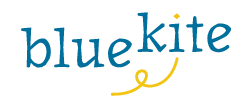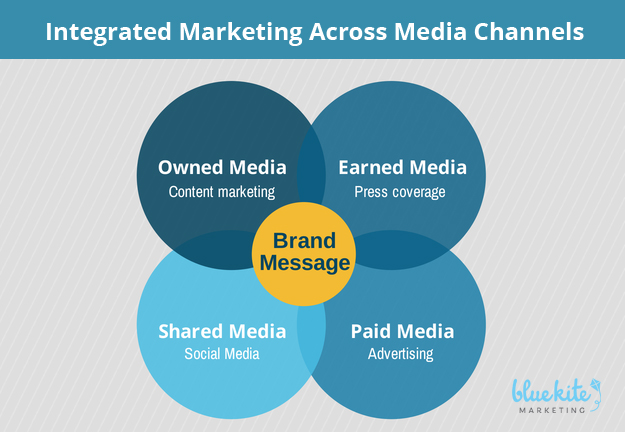When companies call us for marketing help, typically they have one particular issue or pain point.
Maybe they need a new website or collateral materials. Or, perhaps they want to get started with blogging and content marketing. Or, they’re looking to get some press for their work.
Although they may in fact need those things, oftentimes, the need is much greater than that. Those items have simply bubbled to the surface as pain points.
When it comes to marketing, business benefit most from an integrated marketing plan. Integrated marketing is when you take your brand message and use it consistently across the four main types of media channels.
Brands that do this well are the ones that seem to be everywhere you look — in the news, on social media channels and in ads across various media.
When you combine these four media channels, you get maximum exposure for your brand. And that’s why brands that implement an integrated marketing effort are most likely to see success.
When you focus all of your attention in only one area, your effort will be imbalanced and you might not see results as quickly as you would like.
Types of Media for Integrated Marketing
So what does an integrated marketing effort look like? The tactics will look different for every business, but the effort should combine these four types of media.
1. Owned Media
Owned media this is the content you create and house on a web property that you own. I call this your home base.
The rest of your efforts — earned, paid and shared media — should help drive people to your home base, which is where you drive leads and sales.
If you’re just starting out or if you have limited funds, owned media or content marketing is where you should focus your attention first. Once you have built a solid home base, then you can focus on the rest of your integrated marketing effort.
This is what’s included in owned media or content marketing:
- Blogging
- Podcasts, videos and photos
- EBooks, white papers, workbooks and premium content
- Webinars, conferences and events
- Email marketing
- Search Engine Optimization (SEO)
2. Earned Media
Earned media is what we think of as publicity or media relations. This means getting publicity or media for your brand without paying for it.
In the most traditional sense, this is when a news reporter writes a story that includes your company.
This could be everything from a full feature of your company to simply quoting someone from your company as a source.
As the media landscape as evolved, owned media goes beyond traditional media channels (newspapers, magazines, radio and TV) to include blogs and other digital media sources.
People trust editorial content more than other types of media, so it pays to make media relations a component of your marketing efforts.
Here are some examples of earned media:
- Media relations or publicity
- Blogger relations and outreach
- Guest columns
- Guest blogging
- Influencer outreach
3. Paid Media
Most people are familiar with paid media, which comes in the form of advertising. This means you are paying someone to promote your brand.
In traditional advertising, this means ads in newspapers, magazines and on TV. In today’s world, this also includes digital ads across many different kinds of media.
Oftentimes, paid media is the most effective way to get your message in front of your target audience. As a result, that can come at a price. Depending on the channels you use, advertising can be very expensive.
However, some digital advertising channels, such as pay-per-click (PPC) advertising and social media advertising have become more accessible to smaller companies.
Here is a sample of paid media options:
- Traditional advertising (print, TV, radio, billboards, etc.)
- Digital display advertising (i.e. banner ads)
- Pay-per-click ads (Google Adwords)
- Social media advertising
- Native advertising or sponsored content
4. Shared Media
In this model, shared media is the newest kid on the media block. Shared media is content that is created and shared between the brand and the community.
The biggest example of this is social media. Although brands can create and share their own content through social media channels, it’s not on a platform they own. And, on top of that, the community also has their own ability to create and share content about brands on social media channels.
Shared media is where interaction and engagement between the brand and their community typically takes place.
Here are some examples of shared media:
- Social media (Twitter, Facebook, LinkedIn, etc.)
- Online reviews (Yelp, Trip Advisor, etc.)
- Forums and online communities
If you’re working on building your marketing plans for next year of if you want to finish out this year strong, you should look at ways to create a balanced, integrated marketing plan to achieve the most success.
Are you using each of these types of media in your marketing? Do you focus primarily on one area more than another?




